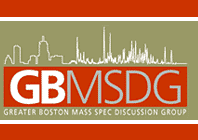GBMSDG Meeting Archives
October 22, 2009
GBMSDG Annual Vendor Night & Dinner Meeting
Guest Speaker
Joshua J. Coon
University of Wisconsin, Madison
Departments of Chemistry & Biomolecular Chemistry
How hybrid mass spectrometers with
multiple analyzers and dissociation methods
will transform protein sequence analysis
Location
Hyatt Regency
575 Memorial Drive, Cambridge
Last year we had over 200 people in attendance
14 GPS systems and a pair of Red Sox playoff tickets were given away
25 vendors participated, all making our Vendor Night a success.
Presentation Abstract
We describe the use of new mass spectrometry technology for the large-scale characterization and quantification of proteomes. The new instrument allows for the implementationof multiple peptide dissociation methods and for the automated selection of each in a real-time based on multiple precursor attributes (i.e., data-dependent decision tree). Protein quantification is readily accomplished through use of isotopic labels – either SILAC or iTRAQ. The instrument will likewise propel top-down proteomics as acquisition of ETD-MS/MS spectra in the high resolving power Orbitrap allows for direct analysis of intact proteins on a sub-second timescale with ~ 300 ppb mass accuracies. Such mass accuracies are used to directly annotate tandem mass spectral peaks with ion type and chemical composition. We demonstrate these and many other aspects of the instrument on a variety of applications involving human embryonic stem (hES) cells. Specifically, induced puripotent stem cells (iPS), which circumvent ethical issues surrounding the use of hES cells and could eliminate immune rejection in transplantation therapies. Using the technology described above we investigated similarities and differences between human ES and iPS cells that may affect the use of iPS cells for research and therapeutic purposes. To date, we have identified over 80,000 unique peptides corresponding to over 8,000 unique proteins. The fold-differences observed between pluripotent lines and the control somatic line showed a high correlation (R = 0.91) demonstrating remarkable similarity between ES and iPS cells. The set of proteins that was expressed at higher levels in pluripotent cells was mostly nuclear in nature and functionally enriched in the processes of transcriptional regulation and chromatin modification. Among these were numerous transcription factors and other proteins important to the maintenance of pluripotency including SOX2, OCT4, DPPA4, and LIN28.

